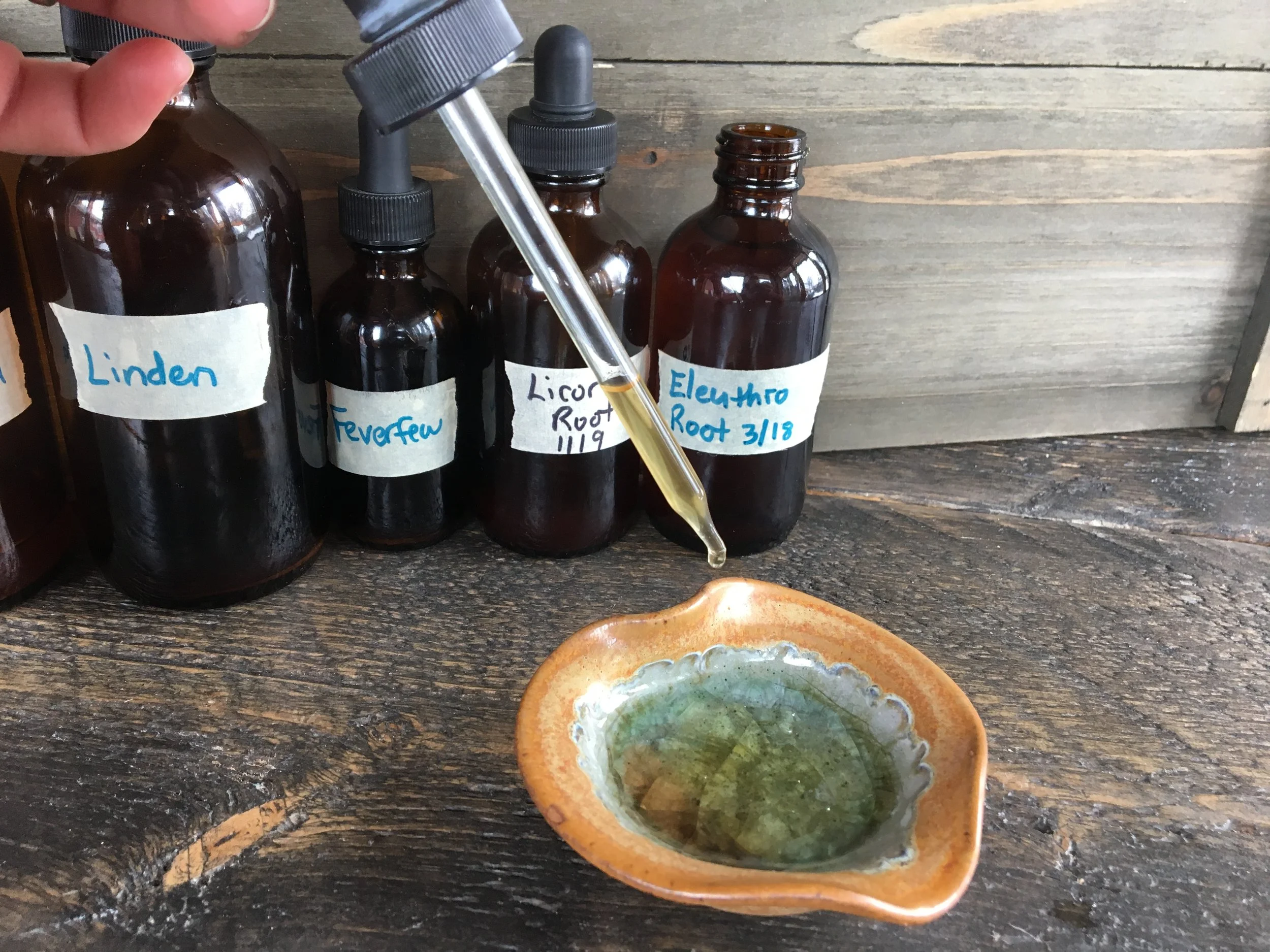Herbal Remedies for Beginners | How to Make a Tincture
Today is our last post in the series Herbal Remedies for Beginner’s. We will be learning all about tinctures which happens to be one of my favorite herbal remedies. If you would like to catch up on the other posts in this series you can do so by clicking the links below:
-How to make an herbal tea and infusion
I feel very strongly that everyone should learn to make tinctures because of how beneficial they can be. I also realize that making tinctures can seem totally freak-a-zoid weird if you've never made one before. I felt totally lost when I first started, too. But trust me. I know several people, including myself, who finally sucked it up, gave it a try and now are totally hooked on tincture making. It's actually slightly addicting—you should see my tincture stash.
Feel free to ask me any questions you might have in the comments! I'm certainly not an expert but I will answer to the best of my knowledge.
What is a tincture?
A tincture is made by soaking one or more herbs for an extended period of time in some type of alcohol. By doing this the beneficial nutrients in the herbs are released or extracted into the alcohol. Very simply put, a tincture is a type of herbal extract, because the nutrients are extracted into the alcohol. The result is a very concentrated liquid that is highly nutritious.
Different types of alcohol can be used in tincture making depending on your preference, but I tend to use vodka or brandy. Ideally you would use 100 proof alcohol, although I can generally only find 80 proof which is perfectly acceptable.
100 proof means it is 50% alcohol and 50% water. This is ideal because certain nutrients in herbs are water soluble and others such as alkaloids and flavonoids are not. So you get the best of both worlds by using alcohol versus, say, making an infusion which only extracts the water soluble nutrients.
You can also make a tincture using glycerin if you are opposed to using alcohol, or plan on giving it to small children. The method is the same, so feel free to use glycerin if you wish.
What kinds of herbs can you use?
You can use nearly any type of herb or spice you wish to make a tincture. However, certain herbs have contraindications so it is always wise to do your research and know the medicinal compounds of the herbs you are using.
I generally use dried herbs but you can use fresh as well. Keep in mind, though, that if you use fresh herbs you will need to use about twice as much herb. You may also have to watch for mold growth while it is infusing, but if you are using an appropriate proof alcohol this shouldn’t be cause for concern.
Why make a tincture?
There are so many reasons to make tinctures but here are a few of my favorite one.
Due to the alcohol in tinctures, the liquid goes right for your liver which is a great way to get the nutrients in the herbs into your body
Tinctures are easy to take making them great for daily use
You control what goes in them
You have the freedom to create any type of herbal combination that works for your health needs
Generally speaking, tinctures are quite affordable, especially if you grow some of the herbs yourself or gather them in the wild
During the process of tincture making, the nutrients in the herbs are broken down which makes them very easily digested and absorbed by the body
Tinctures have a long shelf life (years)
Easy to make once you get the hang of it
How do you take a tincture?
You can either use a dropper and squirt the tincture directly into your mouth, or you can mix it with water or juice. I prefer adding mine to a little water and drinking it down quick. Some are more potent than others, so sometimes I have to plug my nose. But many are not bad tasting at all and some can be quite pleasant.
What kind of equipment do you need to get started?
This is the best part about tincture making. Other than the herbs and the alcohol, the equipment is extremely simple.
Glass jars of various sizes with lids (mason jars work great)
Cheese cloth OR clean rags, t-shirts, etc.
Rubber band
Fine mesh strainer
Glass measuring bowl with spout (makes the process easier, but not necessary)
Glass bottles to store the finished tinctures in. Preferably amber bottles so they are protected from the sun. I buy mine from here or here. However, to keep it cheap you can use mason jars. Just be sure to store them out of the sun.
Please note: Glass jars are strongly recommended because plastic can leach nastiness into your brew. On the flip side, some of your nutrients can be leached into the plastic. Either way, glass is your best choice.
Folk versus Ratio Tinctures
There are two ways to make a tincture. Today I am going to show you how to make the easiest version which is called the folk method. This method is more or less eyeballing your herb and alcohol amounts. It’s less technical, but works quite well for home use.
The other method, which is much more consistent and scientific is the ratio method. If you’ve ever purchased a tincture from the store you may have seen a ratio such as 1:5 on the label. What that means is the tincture was made using 1 part herb by weight to 5 parts alcohol by volume. An example would be 1 ounce herb to 2 fluid ounces of brandy. Another popular ratio is 1:2 which is a much stronger tincture since the liquid amount is much less.
If you love numbers, feel free to use the ratio method. As I said, it is much more accurate and consistent, however I find this method intimidates most people so the folk method is a great jumping off point.
How to Make a Basic Folk Tincture
You will need:
Herb of choice
Alcohol of choice (or glycerin)
Mason jar (wide mouth works best)
Directions:
Start by filling your jar about ½ way full of herbs. Slowly pour the alcohol over the herbs so it covers them by at least an inch or two. Be sure and leave some space at the top, though, as the herbs will expand as they soak up the alcohol.
Give the herbs a little stir to make sure they are all fully saturated with alcohol, adding more alcohol as needed.
Cover the jar tightly with a lid, give it a good shake and prepare to wait for 4-6 weeks.
Oh but first label the jar. This is very important! Trust me, once you leave this sit for awhile you will forget what you put in the jar. Label it with the herb you used, what type of alcohol and the date.
Okay, now you can go ahead and sit your jar in a cool dark location. Every once in awhile give it a good shake to agitate the herbs a bit which helps the extraction process.
After 4-6 weeks (or longer if you happen to forget it’s in the cupboard) it’s time to strain off the liquid.
You can use a mesh strainer if you prefer, but I find you get more liquid out by using the following method:
Attach a clean old dish towel or t-shirt to a pyrex glass measuring cup with a rubber band. Pour the tincture mixture in and let it strain through. Gather up the ends of the dish towel and squeeze out all the precious liquid. And yes, look out, as you may accidentally squirt juice all over.
Discard the herbs and pour your brand new tincture into a dark glass jar. Make sure label it and store in a cool dark location.
That’s it! You did it! You made a tincture! Do you feel all wickedly herbal?
If you’re still intimidated, check out my tutorial for vanilla extract which is the most basic type of tincture you can make.
WHERE TO PURCHASE
I appreciate you taking the time to read my blog! By purchasing through one of my affiliate links you will not spend a penny more, but you are allowing me to receive a small commission. This allows me to keep posting great content for you. Thanks for your support! Read more here.
If you are unable to grow your own herbs, or find ingredients locally, then here are two of my favorite places to buy bulk ingredients:
This company is where I purchase the majority of my seeds. Great selection of heirloom and/or organic seeds:
These are hands down my favorite seed starting trays and pots. These are heavy duty and don’t crumple when you pop your plants out! Definitely worth the investment in my opinion.
Now drop me a comment and let me know what the first tincture you ever made was!!





